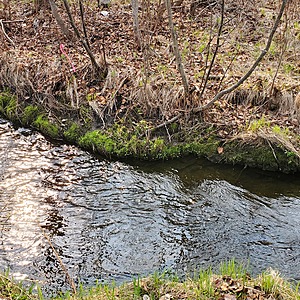
Junction Creek
Sudbury, Ontario, Canada

- Group: Junction Creek Stewardship Committee
- Lat: 46.5277159
- Lng: -80.9262586
- Waterbody Type: Creek
- Timezone: America/Toronto
Latest photos
View all photosWe sampled at the usual location, taking all required parameters without issue. The creek was flowing low and slow. The sampling pole was broken, so we just reached into the water as far as we safely could. The conductivity meter wasn't calibrated, but it became accurate after the batteries were changed.
We sampled at the usual location, taking all required parameters mostly without issue. The creek was flowing somewhat higher and faster due to recent rainfall, but this did not pose a problem for us. However, the repaired sampling pole started to break when attaching the sampling cup, so we just reached into the water as far as we safely could. As per usual, we removed batteries from the conductivity meter after sampling and put them in the waterproof phone case within the kit.
We sampled at the usual location; the creek’s flow was low and slow, like it was back in June. We measured all required parameters without issue. This time, we had the opportunity to show 3 people (a mother with 2 young children) how the testing works. One of the kids even got hands-on experience taking the water sample with us! When we finished testing, we removed batteries from the conductivity meter and put them in the waterproof phone case within the kit.
We sampled at the usual location (same as last month), taking all required parameters without issue. The creek was flowing somewhat higher and faster due to recent rainfall, but this did not pose a problem for us. This time, we were able to use the repaired sampling pole without breaking it. Like last month we removed batteries from the conductivity meter after sampling, and put them in the waterproof phone case within the kit. It should also be noted that the dissolved oxygen standards – those built into the comparison chart in the kit – apparently expired back in February 2022. Water Rangers has been contacted to see how urgent it is to replace these and the best way to dispose of them.
Prior to heading out, we calibrated the conductivity meter; according to Water Rangers, it won’t need to be calibrated for another 6 months. When we got to Twin Forks, we sampled at a spot (46°31'40.4"N,80°55'34.1"W) just a short distance downstream of the gravel path that runs along the baseball diamond. We presumed this was close enough to the intended sampling location.
The creek’s flow was low and slow. We followed the sampling protocol as well as the recommendation from the April sampling crew regarding test strips. The only issue is that we broke the sampling pole when folding the plastic part to put it away. Also note that we removed batteries from the conductivity meter – since it won’t be used for another month – and put them in the waterproof phone case within the kit.
We got to the Twin Forks sampling location, brought all the equipment to the sampling site but noticed that it was not easy to get to the water, so we had to walk 255 m down stream to find a safe location to sample. The reason the original spot was not safe, was because there was too much overhanging ice and fast current so we found a more secure location where we could access the water without having the risk of falling in.
Before starting to sample we took everything we needed out and started filling out the notebook with the air temperature, weather, 24hr weather, time, date, coordinates, and place. We took the temperature of the water, conductivity, used the strip that indicated chlorine, pH, alkalinity, and total hardness, dissolved oxygen and then took the depth of the water.
We would recommend that next time we bring the sampling jar pole to facilitate getting the water at the regular sampling spot. Another thing that could be done is to start sampling a little later in the month or year so there is no overhanging ice ledge. Lastly, we noticed that the readings on the strip are not like the previous year’s readings, we presume it’s because instead of directly putting the test strip in the water it was easier to put water in a jar then take the sample from there so the readings are a little off. Next time we sample we should put the test strip directly into the stream for optimum results.


